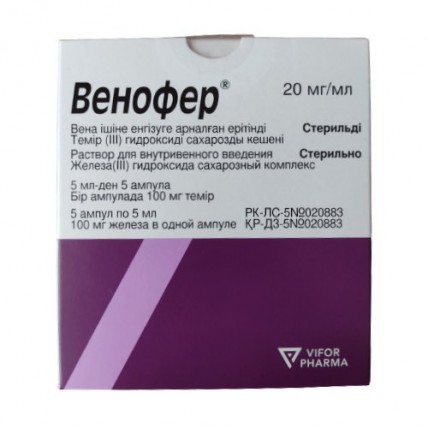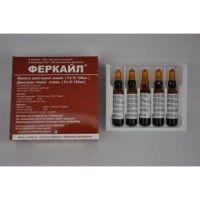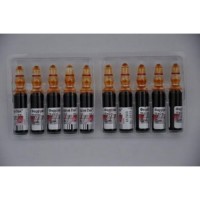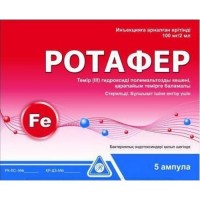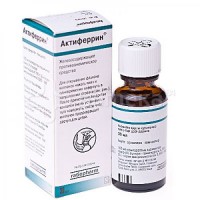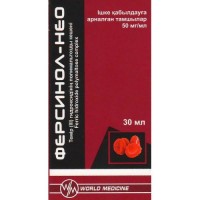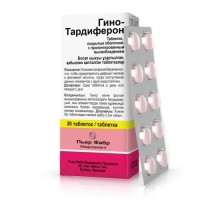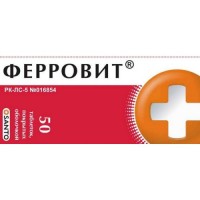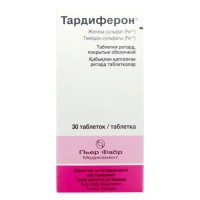Compound
1 ml of the drug contains
Distribution
The ferrokinetics of the iron-sucrose complex labeled with 52Fe and 59Fe was evaluated in 6 patients with anemia and chronic renal failure. During the first 6–8 hours, 52Fe was taken up by the liver, spleen, and bone marrow. It is believed that the uptake of the radioactive label by the macrophage-rich spleen is characteristic of the uptake of iron by the reticuloendothelial system.
Following a single intravenous injection of a dose of iron-sucrose complex containing 100 mg of iron to healthy volunteers, peak total serum iron concentrations were recorded 10 minutes after injection and averaged 538 µmol/L. The volume of distribution in the central compartment exactly matched the plasma volume (approximately 3 liters).
Biotransformation
After injection, most of the sucrose dissociates, and the multinuclear iron-containing nucleus is taken up mainly by the reticuloendothelial system of the liver, spleen, and bone marrow. At 4 weeks post-administration, erythrocyte utilization ranged from 59 to 97%.
breeding
The average molecular weight (MM) of the iron-sucrose complex is approximately 43 kDa, which is high enough to prevent renal excretion. The excretion of iron by the kidneys, which occurs during the first 4 hours after the injection of a dose of Venofer containing 100 mg of iron, corresponded to less than 5% of the administered dose. After 24 hours, the total serum iron concentration decreased to the level noted before the administration of the drug. Excretion of sucrose by the kidneys was approximately 75% of the administered dose.
Mechanism of action
The active component of the drug Venofer - iron-sucrose complex - consists of a polynuclear core of iron (III) hydroxide, surrounded by a large number of non-covalently bound sucrose molecules. The average molecular weight (MM) of this complex is approximately 43 kDa. The structure of the multinuclear iron-containing core is similar to the structure of the core of the ferritin protein, the physiological depot of iron. This complex is designed to create a controlled source of utilizable iron for proteins responsible for the transport and storage of iron in the body (transferrin and ferritin, respectively).
After intravenous administration, the multinuclear iron-containing nucleus, which is part of this complex, is captured mainly by the reticuloendothelial system of the liver, spleen and bone marrow. At the next stage, iron is used for the synthesis of hemoglobin, myoglobin and other iron-containing enzymes, or is deposited mainly in the liver in the form of ferritin.
Venofer is intended for the treatment of iron deficiency conditions in the following situations:
- if you need a quick replenishment of iron stores
- in patients who cannot tolerate oral iron preparations or do not comply with the treatment regimen
- in the presence of active inflammatory bowel disease, when oral iron preparations are ineffective.
Venofer should be used only in cases where the indication for use is confirmed by the results of appropriate laboratory studies.
Mode of application
Venofer is administered only intravenously. It can be administered by drip infusion, slow injection, or directly into the venous site of the dialysis system. The drug is not intended for intramuscular injection.
Intravenous drip infusion
Venofer is diluted only with a sterile 0.9% solution of sodium chloride (NaCl) (mass / volume). Dilution should be done immediately before the infusion, and the resulting solution should be administered as follows:
Dilution of the drug to lower concentrations of iron is unacceptable.
intravenous injection
Venofer can be administered by slow intravenous injection at a rate of 1 ml of undiluted solution per minute and its dose should not exceed 10 ml (200 mg of iron) per injection for at least 10 minutes.
Introduction to the venous site of the dialysis system
Venofer can be administered during a hemodialysis session directly into the venous site of the dialysis system under the same conditions as for intravenous injection.
Dose
For each patient, the cumulative dose of Venofer should be calculated individually, which should not be exceeded. The schedule of administration should also be drawn up individually for each patient.
Standard doses
adults
5-10 ml of Venofer (100-200 mg of iron) 1-3 times a week, depending on the level of hemoglobin.
The time of administration of the drug and the method of dilution are indicated in the section "Method of application".
Maximum tolerated single and weekly doses:
adults
The maximum tolerated dose per day, administered as an injection no more than 3 times a week:
10 ml of Venofer (200 mg of iron) administered over at least 10 minutes
The maximum tolerated dose per day, administered as an infusion no more than once a week:
Patients weighing more than 70 kg: 500 mg of iron (25 ml of Venofer) administered over a period of at least 3.5 hours
Patients weighing 70 kg or less: 7 mg iron/kg body weight administered over a minimum of 3.5 hours
You should strictly adhere to the time of infusion indicated in the subsection "Method of application", even if the patient does not receive the maximum tolerated single dose.
Dosage calculation
The total cumulative dose of Venofer, equivalent to total iron deficiency (mg), is determined based on the level of hemoglobin (Hb) and body weight (BW). The dose of Venofer should be calculated individually for each patient in accordance with the total iron deficiency calculated using the Ganzoni formula below, for example:
The total amount of Venofer (ml) to be administered, depending on body weight, actual Hb level and target Hb level*:
To convert Hb (mmol) to Hb (g/dL), multiply the first value by 1.6.
If the total required dose exceeds the maximum permitted single dose, it should be divided into several doses.
If 1-2 weeks after the start of treatment with Venofer, there is no response from hematological parameters, the initial diagnosis should be reconsidered.
Children
The use of the drug Venofer by children has not been sufficiently studied, therefore it is not recommended for use in children.
The most common adverse drug reaction (ADR) recorded in the clinical trials of the drug Venofer was a change in taste sensations, which was observed with a frequency of 4.5 events per 100 subjects. The most important serious adverse drug reactions associated with the use of the drug Venofer were hypersensitivity reactions, which were observed in clinical studies with a frequency of 0.25 events per 100 subjects.
Below are the adverse drug reactions reported after the use of Venofer in 4046 subjects in clinical trials.
Often ( ≥1/100, <1/10)
- disturbance of taste sensations
- arterial hypotension, arterial hypertension
- nausea
- pain at the injection site
Uncommon ( ≥1/1000, <1/100)
- polycythemia1)
- increased sensitivity
- headache, dizziness, burning sensation, paresthesia, hypoesthesia
- thrombophlebitis, phlebitis
- shortness of breath
- chromaturia
- vomiting, abdominal pain, diarrhea, constipation
- itching, rash
- muscle cramps, myalgia, arthralgia, pain in the extremities, back pain
- chills, reactions at the injection site, irritation at the injection site, extravasation at the injection site, discoloration of the skin at the injection site, burning sensation at the injection site, swelling at the injection site, asthenia, fatigue, pain
Rarely ( ≥1/10,000, <1/1000)
- pneumonia
- iron overload
- fainting, migraine, drowsiness
- sensation of heartbeat
- hyperemia
- dry mouth
- sensation of discomfort in the limbs, muscle spasms
- feeling of heat, chest pain, pyrexia, swelling, itching at the injection site, bruising at the injection site
- peripheral edema
Pathological changes in laboratory parameters
Uncommon (≥1/1000, <1/100 )
- increased levels of gamma-glutamyl transferase, increased levels of alanine aminotransferase, increased levels of aspartate aminotransferase, pathological changes in the results of liver tests
Rarely ( ≥1/10,000, <1/1000)
- increased serum ferritin1), increased blood creatinine, increased blood lactate dehydrogenase
1) Possibly as a consequence of iron overdose or iron overload
Adverse reactions observed in the post-registration period, some of which can be potentially fatal
Frequency unknown:
- anaphylactoid reactions, angioedema
- decreased level of consciousness, confusion, loss of consciousness, anxiety, tremor
- bradycardia, tachycardia
- vascular collapse, thrombosis of superficial veins
- bronchospasm
- urticaria, erythema
- muscle hypotension
- hyperhidrosis, cold sweat, general malaise, pallor
- hypersensitivity to the iron-sucrose complex, Venofer or any of the excipients listed in the "Composition" section
- known hypersensitivity to other parenteral iron preparations
- anemia not associated with iron deficiency
- the presence of signs of iron overload or congenital disorders of the processes of its utilization
- first trimester of pregnancy
As with all parenteral iron preparations, Venofer is not recommended for use concomitantly with oral iron preparations, since oral iron absorption may be reduced.
Venofer is diluted only with a sterile 0.9% sodium chloride solution (w/v). When mixed with other solutions or drugs, there is a risk of precipitation and / or interaction. Compatibility with containers made of materials other than glass, polyethylene and PVC has not been studied.
Treatment with Venofer should be prescribed only after a thorough diagnosis by the attending physician.
Parenterally administered iron preparations can cause anaphylactic/anaphylactoid reactions, which can be potentially fatal. Hypersensitivity reactions have also been reported following previous uncomplicated administrations of parenteral iron complexes, including the iron-sucrose complex. Patients should be actively questioned before each administration of Venofer regarding the side effects of the drug. Venofer should be used by personnel trained in the detection and management of anaphylactic reactions, antiallergic drugs should be available, as well as cardiopulmonary resuscitation equipment and procedures. After each injection of the drug Venofer, all patients should be observed for the absence of adverse events for at least 30 minutes.
In the event of an allergic reaction, treatment should be discontinued immediately. Anti-shock therapy (0.1% adrenaline solution, antihistamines and/or corticosteroids) should be provided.
The risk of hypersensitivity reactions is increased in patients with known allergies, including drug allergies, in patients with bronchial asthma, eczema, or other atopic allergic reactions. The risk of hypersensitivity reactions to parenteral iron complexes is also increased in patients with immunological and inflammatory diseases (eg, systemic lupus erythematosus, rheumatoid arthritis).
In patients with hepatic impairment, parenteral iron should only be used after a careful assessment of the risk-benefit ratio. Patients with impaired liver function, when iron overload is a provoking factor, in particular, the development of tardive porphyria of the skin, should not use parenteral iron. In order to avoid iron overload, careful monitoring of iron levels in the body is recommended.
Parenteral iron should be used with caution in the presence of acute or chronic infection. Patients with ongoing bacteremia are advised to stop using Venofer. In patients with chronic infection, an assessment of the risk-benefit ratio should be made, taking into account the possibility of suppressing erythropoiesis.
Episodes of hypotension may develop if the drug is administered too quickly. Allergic reactions, sometimes including arthralgia, were observed more often when the recommended dose was exceeded. Perivenous leakage should be avoided, since leakage of Venofer at the injection site can lead to pain, inflammation, tissue necrosis and brown discoloration of the skin.
Features of use after the first opening of the container
From a microbiological point of view, the drug should be used immediately.
Application features after dilution with 0.9% sodium chloride solution ( NaCl ) (mass/volume)
It has been shown that the chemical and physical stability after dilution is 12 hours at room temperature. From a microbiological point of view, the drug should be used immediately. If the product is not used immediately after reconstitution, the user is responsible for the storage conditions and time after reconstitution, which in any case should not exceed 3 hours at room temperature, unless reconstitution has been performed under controlled and validated aseptic conditions.
Use during pregnancy and lactation
Pregnancy period
Properly controlled studies of the use of Venofer in pregnant women have not been conducted to date. Allergic reactions to parenteral iron preparations that develop during pregnancy endanger the life of the mother and child. Intravenous iron preparations should not be used during pregnancy unless absolutely necessary. Venofer should only be used in the second and third trimesters of pregnancy when the potential benefit to the mother outweighs the potential risk to the fetus.
The use of the drug in the first trimester of pregnancy is contraindicated.
Animal studies have shown no direct or indirect adverse effects on pregnancy, embryonic/fetal development, childbirth or postnatal development. Data from a limited number of pregnant women indicate no adverse effect of Venofer on pregnancy or fetal/newborn health.
lactation period
Data on the excretion of iron in human breast milk after intravenous administration of iron-sucrose complex is limited. In one clinical study, 10 healthy, breastfeeding mothers with iron deficiency received 100 mg of iron as an iron-sucrose complex. 4 days after treatment, the iron content in breast milk did not increase, and no difference was observed compared with the control group (n=5). It cannot be ruled out that iron from the Venofer preparation can be supplied to the newborn / infant with mother's milk, therefore the drug should be prescribed with caution, taking into account the assessment of the ratio between risk and benefit.
The results of preclinical studies have not revealed direct or indirect harmful effects on the child who is breastfed. In lactating rats injected with 59Fe-labeled iron-sucrose complex, a low degree of iron secretion into milk and iron transfer to offspring was observed. It is unlikely that an unmetabolized iron-sucrose complex will pass into breast milk.
Features of the influence of the drug on the ability to drive a vehicle or potentially dangerous mechanisms
It is unlikely that the drug Venofer may affect the ability to drive vehicles or work with other automated systems. However, if symptoms such as dizziness, confusion or fainting develop after the use of the drug Venofer, patients should not drive vehicles or work with other automated systems until these symptoms disappear.
Symptoms: Overdose can cause iron overload, which itself can present with symptoms of hemosiderosis.
Treatment: Overdose should be treated, at the discretion of the treating physician, using an iron chelator or in accordance with standard medical practice.
Store at a temperature not exceeding 25 °C. The drug is not subject to freezing!
Keep out of the reach of children!
Shelf life - 3 years
Do not use after the expiry date stated on the packaging.
1 ml of the drug contains
- Active ingredient - Iron (III) 20 mg (in the form of iron (III) hydroxide of the sucrose complex 510-570 mg)
- Excipients: sodium hydroxide (10% solution), water for injection.
Pharmacological properties
Pharmacokinetics
Distribution
The ferrokinetics of the iron-sucrose complex labeled with 52Fe and 59Fe was evaluated in 6 patients with anemia and chronic renal failure. During the first 6–8 hours, 52Fe was taken up by the liver, spleen, and bone marrow. It is believed that the uptake of the radioactive label by the macrophage-rich spleen is characteristic of the uptake of iron by the reticuloendothelial system.
Following a single intravenous injection of a dose of iron-sucrose complex containing 100 mg of iron to healthy volunteers, peak total serum iron concentrations were recorded 10 minutes after injection and averaged 538 µmol/L. The volume of distribution in the central compartment exactly matched the plasma volume (approximately 3 liters).
Biotransformation
After injection, most of the sucrose dissociates, and the multinuclear iron-containing nucleus is taken up mainly by the reticuloendothelial system of the liver, spleen, and bone marrow. At 4 weeks post-administration, erythrocyte utilization ranged from 59 to 97%.
breeding
The average molecular weight (MM) of the iron-sucrose complex is approximately 43 kDa, which is high enough to prevent renal excretion. The excretion of iron by the kidneys, which occurs during the first 4 hours after the injection of a dose of Venofer containing 100 mg of iron, corresponded to less than 5% of the administered dose. After 24 hours, the total serum iron concentration decreased to the level noted before the administration of the drug. Excretion of sucrose by the kidneys was approximately 75% of the administered dose.
Pharmacodynamics
Mechanism of action
The active component of the drug Venofer - iron-sucrose complex - consists of a polynuclear core of iron (III) hydroxide, surrounded by a large number of non-covalently bound sucrose molecules. The average molecular weight (MM) of this complex is approximately 43 kDa. The structure of the multinuclear iron-containing core is similar to the structure of the core of the ferritin protein, the physiological depot of iron. This complex is designed to create a controlled source of utilizable iron for proteins responsible for the transport and storage of iron in the body (transferrin and ferritin, respectively).
After intravenous administration, the multinuclear iron-containing nucleus, which is part of this complex, is captured mainly by the reticuloendothelial system of the liver, spleen and bone marrow. At the next stage, iron is used for the synthesis of hemoglobin, myoglobin and other iron-containing enzymes, or is deposited mainly in the liver in the form of ferritin.
Indications for use
Venofer is intended for the treatment of iron deficiency conditions in the following situations:
- if you need a quick replenishment of iron stores
- in patients who cannot tolerate oral iron preparations or do not comply with the treatment regimen
- in the presence of active inflammatory bowel disease, when oral iron preparations are ineffective.
Venofer should be used only in cases where the indication for use is confirmed by the results of appropriate laboratory studies.
Dosage and administration
Mode of application
Venofer is administered only intravenously. It can be administered by drip infusion, slow injection, or directly into the venous site of the dialysis system. The drug is not intended for intramuscular injection.
Intravenous drip infusion
Venofer is diluted only with a sterile 0.9% solution of sodium chloride (NaCl) (mass / volume). Dilution should be done immediately before the infusion, and the resulting solution should be administered as follows:
| Dose of Venofer (mg iron) | Dose of Venofer (ml Venofer) | Maximum volume of sterile 0.9% NaCl solution for dilution (mass/volume) | Minimum infusion time |
| 100 mg | 5 ml | 100 ml | 15 minutes |
| 200 mg | 10 ml | 200 ml | 30 minutes |
| 300 mg | 15 ml | 300 ml | 1,5 hour |
| 400 mg | 20 ml | 400 ml | 2.5 hours |
| 500 mg | 25 ml | 500 ml | 3.5 hours |
Dilution of the drug to lower concentrations of iron is unacceptable.
intravenous injection
Venofer can be administered by slow intravenous injection at a rate of 1 ml of undiluted solution per minute and its dose should not exceed 10 ml (200 mg of iron) per injection for at least 10 minutes.
Introduction to the venous site of the dialysis system
Venofer can be administered during a hemodialysis session directly into the venous site of the dialysis system under the same conditions as for intravenous injection.
Dose
For each patient, the cumulative dose of Venofer should be calculated individually, which should not be exceeded. The schedule of administration should also be drawn up individually for each patient.
Standard doses
adults
5-10 ml of Venofer (100-200 mg of iron) 1-3 times a week, depending on the level of hemoglobin.
The time of administration of the drug and the method of dilution are indicated in the section "Method of application".
Maximum tolerated single and weekly doses:
adults
The maximum tolerated dose per day, administered as an injection no more than 3 times a week:
10 ml of Venofer (200 mg of iron) administered over at least 10 minutes
The maximum tolerated dose per day, administered as an infusion no more than once a week:
Patients weighing more than 70 kg: 500 mg of iron (25 ml of Venofer) administered over a period of at least 3.5 hours
Patients weighing 70 kg or less: 7 mg iron/kg body weight administered over a minimum of 3.5 hours
You should strictly adhere to the time of infusion indicated in the subsection "Method of application", even if the patient does not receive the maximum tolerated single dose.
Dosage calculation
The total cumulative dose of Venofer, equivalent to total iron deficiency (mg), is determined based on the level of hemoglobin (Hb) and body weight (BW). The dose of Venofer should be calculated individually for each patient in accordance with the total iron deficiency calculated using the Ganzoni formula below, for example:
| Total iron deficiency = body weight × (target Hb level - actual Hb level ) x 2.4* + deposited iron | |||
| With body weight less than 35 kg: | Target Hb = 13 g/dl, iron deposited = 15 mg/kg body weight | ||
| With body weight 35 kg or more: | Target Hb = 15 g/dl, iron deposited = 500 mg | ||
| * Factor 2.4 = 0.0034 (iron content in Hb = 0.34%) × 0.07 (blood volume = 7% of body weight) × 1000 (conversion from to ) × 10 | |||
| The total amount of the drug Venofer, which should be = inject (in ml) | Total iron deficiency 20 mg iron/ml | ||
The total amount of Venofer (ml) to be administered, depending on body weight, actual Hb level and target Hb level*:
MT | The total amount of Venofer (20 mg iron per ml) to be administered: | |||||||
| Hb 6.0 g/dL | Hb 7.5 g/dL | Hb 9.0 g/dl | Hb 10.5 g/dL | |||||
| mg Fe | ml | mg Fe | ml | mg Fe | ml | mg Fe | ml | |
| 30 kg | 960 | 48 | 840 | 42 | 740 | 37 | 640 | 32 |
| 35 kg | 1260 | 63 | 1140 | 57 | 1000 | fifty | 880 | 44 |
| 40 kg | 1360 | 68 | 1220 | 61 | 1080 | 54 | 940 | 47 |
| 45 kg | 1480 | 74 | 1320 | 66 | 1140 | 57 | 980 | 49 |
| 50 kg | 1580 | 79 | 1400 | 70 | 1220 | 61 | 1040 | 52 |
| 55 kg | 1680 | 84 | 1500 | 75 | 1300 | 65 | 1100 | 55 |
| 60 kg | 1800 | 90 | 1580 | 79 | 1360 | 68 | 1140 | 57 |
| 65 kg | 1900 | 95 | 1680 | 84 | 1440 | 72 | 1200 | 60 |
| 70 kg | 2020 | 101 | 1760 | 88 | 1500 | 75 | 1260 | 63 |
| 75 kg | 2120 | 106 | 1860 | 93 | 1580 | 79 | 1320 | 66 |
| 80 kg | 2220 | 111 | 1940 | 97 | 1660 | 83 | 1360 | 68 |
| 85 kg | 2340 | 117 | 2040 | 102 | 1720 | 86 | 1420 | 71 |
| 90 kg | 2440 | 122 | 2120 | 106 | 1800 | 90 | 1480 | 74 |
| *With body weight less than 35 kg: | Target Hb = 13 g/dl |
| With a body weight of 35 kg or more: | Target Hb = 15 g/dl |
To convert Hb (mmol) to Hb (g/dL), multiply the first value by 1.6.
If the total required dose exceeds the maximum permitted single dose, it should be divided into several doses.
If 1-2 weeks after the start of treatment with Venofer, there is no response from hematological parameters, the initial diagnosis should be reconsidered.
Children
The use of the drug Venofer by children has not been sufficiently studied, therefore it is not recommended for use in children.
Side effects
The most common adverse drug reaction (ADR) recorded in the clinical trials of the drug Venofer was a change in taste sensations, which was observed with a frequency of 4.5 events per 100 subjects. The most important serious adverse drug reactions associated with the use of the drug Venofer were hypersensitivity reactions, which were observed in clinical studies with a frequency of 0.25 events per 100 subjects.
Below are the adverse drug reactions reported after the use of Venofer in 4046 subjects in clinical trials.
Often ( ≥1/100, <1/10)
- disturbance of taste sensations
- arterial hypotension, arterial hypertension
- nausea
- pain at the injection site
Uncommon ( ≥1/1000, <1/100)
- polycythemia1)
- increased sensitivity
- headache, dizziness, burning sensation, paresthesia, hypoesthesia
- thrombophlebitis, phlebitis
- shortness of breath
- chromaturia
- vomiting, abdominal pain, diarrhea, constipation
- itching, rash
- muscle cramps, myalgia, arthralgia, pain in the extremities, back pain
- chills, reactions at the injection site, irritation at the injection site, extravasation at the injection site, discoloration of the skin at the injection site, burning sensation at the injection site, swelling at the injection site, asthenia, fatigue, pain
Rarely ( ≥1/10,000, <1/1000)
- pneumonia
- iron overload
- fainting, migraine, drowsiness
- sensation of heartbeat
- hyperemia
- dry mouth
- sensation of discomfort in the limbs, muscle spasms
- feeling of heat, chest pain, pyrexia, swelling, itching at the injection site, bruising at the injection site
- peripheral edema
Pathological changes in laboratory parameters
Uncommon (≥1/1000, <1/100 )
- increased levels of gamma-glutamyl transferase, increased levels of alanine aminotransferase, increased levels of aspartate aminotransferase, pathological changes in the results of liver tests
Rarely ( ≥1/10,000, <1/1000)
- increased serum ferritin1), increased blood creatinine, increased blood lactate dehydrogenase
1) Possibly as a consequence of iron overdose or iron overload
Adverse reactions observed in the post-registration period, some of which can be potentially fatal
Frequency unknown:
- anaphylactoid reactions, angioedema
- decreased level of consciousness, confusion, loss of consciousness, anxiety, tremor
- bradycardia, tachycardia
- vascular collapse, thrombosis of superficial veins
- bronchospasm
- urticaria, erythema
- muscle hypotension
- hyperhidrosis, cold sweat, general malaise, pallor
Contraindications
- hypersensitivity to the iron-sucrose complex, Venofer or any of the excipients listed in the "Composition" section
- known hypersensitivity to other parenteral iron preparations
- anemia not associated with iron deficiency
- the presence of signs of iron overload or congenital disorders of the processes of its utilization
- first trimester of pregnancy
Drug Interactions
As with all parenteral iron preparations, Venofer is not recommended for use concomitantly with oral iron preparations, since oral iron absorption may be reduced.
Venofer is diluted only with a sterile 0.9% sodium chloride solution (w/v). When mixed with other solutions or drugs, there is a risk of precipitation and / or interaction. Compatibility with containers made of materials other than glass, polyethylene and PVC has not been studied.
Special instructions
Treatment with Venofer should be prescribed only after a thorough diagnosis by the attending physician.
Parenterally administered iron preparations can cause anaphylactic/anaphylactoid reactions, which can be potentially fatal. Hypersensitivity reactions have also been reported following previous uncomplicated administrations of parenteral iron complexes, including the iron-sucrose complex. Patients should be actively questioned before each administration of Venofer regarding the side effects of the drug. Venofer should be used by personnel trained in the detection and management of anaphylactic reactions, antiallergic drugs should be available, as well as cardiopulmonary resuscitation equipment and procedures. After each injection of the drug Venofer, all patients should be observed for the absence of adverse events for at least 30 minutes.
In the event of an allergic reaction, treatment should be discontinued immediately. Anti-shock therapy (0.1% adrenaline solution, antihistamines and/or corticosteroids) should be provided.
The risk of hypersensitivity reactions is increased in patients with known allergies, including drug allergies, in patients with bronchial asthma, eczema, or other atopic allergic reactions. The risk of hypersensitivity reactions to parenteral iron complexes is also increased in patients with immunological and inflammatory diseases (eg, systemic lupus erythematosus, rheumatoid arthritis).
In patients with hepatic impairment, parenteral iron should only be used after a careful assessment of the risk-benefit ratio. Patients with impaired liver function, when iron overload is a provoking factor, in particular, the development of tardive porphyria of the skin, should not use parenteral iron. In order to avoid iron overload, careful monitoring of iron levels in the body is recommended.
Parenteral iron should be used with caution in the presence of acute or chronic infection. Patients with ongoing bacteremia are advised to stop using Venofer. In patients with chronic infection, an assessment of the risk-benefit ratio should be made, taking into account the possibility of suppressing erythropoiesis.
Episodes of hypotension may develop if the drug is administered too quickly. Allergic reactions, sometimes including arthralgia, were observed more often when the recommended dose was exceeded. Perivenous leakage should be avoided, since leakage of Venofer at the injection site can lead to pain, inflammation, tissue necrosis and brown discoloration of the skin.
Features of use after the first opening of the container
From a microbiological point of view, the drug should be used immediately.
Application features after dilution with 0.9% sodium chloride solution ( NaCl ) (mass/volume)
It has been shown that the chemical and physical stability after dilution is 12 hours at room temperature. From a microbiological point of view, the drug should be used immediately. If the product is not used immediately after reconstitution, the user is responsible for the storage conditions and time after reconstitution, which in any case should not exceed 3 hours at room temperature, unless reconstitution has been performed under controlled and validated aseptic conditions.
Use during pregnancy and lactation
Pregnancy period
Properly controlled studies of the use of Venofer in pregnant women have not been conducted to date. Allergic reactions to parenteral iron preparations that develop during pregnancy endanger the life of the mother and child. Intravenous iron preparations should not be used during pregnancy unless absolutely necessary. Venofer should only be used in the second and third trimesters of pregnancy when the potential benefit to the mother outweighs the potential risk to the fetus.
The use of the drug in the first trimester of pregnancy is contraindicated.
Animal studies have shown no direct or indirect adverse effects on pregnancy, embryonic/fetal development, childbirth or postnatal development. Data from a limited number of pregnant women indicate no adverse effect of Venofer on pregnancy or fetal/newborn health.
lactation period
Data on the excretion of iron in human breast milk after intravenous administration of iron-sucrose complex is limited. In one clinical study, 10 healthy, breastfeeding mothers with iron deficiency received 100 mg of iron as an iron-sucrose complex. 4 days after treatment, the iron content in breast milk did not increase, and no difference was observed compared with the control group (n=5). It cannot be ruled out that iron from the Venofer preparation can be supplied to the newborn / infant with mother's milk, therefore the drug should be prescribed with caution, taking into account the assessment of the ratio between risk and benefit.
The results of preclinical studies have not revealed direct or indirect harmful effects on the child who is breastfed. In lactating rats injected with 59Fe-labeled iron-sucrose complex, a low degree of iron secretion into milk and iron transfer to offspring was observed. It is unlikely that an unmetabolized iron-sucrose complex will pass into breast milk.
Features of the influence of the drug on the ability to drive a vehicle or potentially dangerous mechanisms
It is unlikely that the drug Venofer may affect the ability to drive vehicles or work with other automated systems. However, if symptoms such as dizziness, confusion or fainting develop after the use of the drug Venofer, patients should not drive vehicles or work with other automated systems until these symptoms disappear.
Overdose
Symptoms: Overdose can cause iron overload, which itself can present with symptoms of hemosiderosis.
Treatment: Overdose should be treated, at the discretion of the treating physician, using an iron chelator or in accordance with standard medical practice.
Storage conditions
Store at a temperature not exceeding 25 °C. The drug is not subject to freezing!
Keep out of the reach of children!
Shelf life - 3 years
Do not use after the expiry date stated on the packaging.
